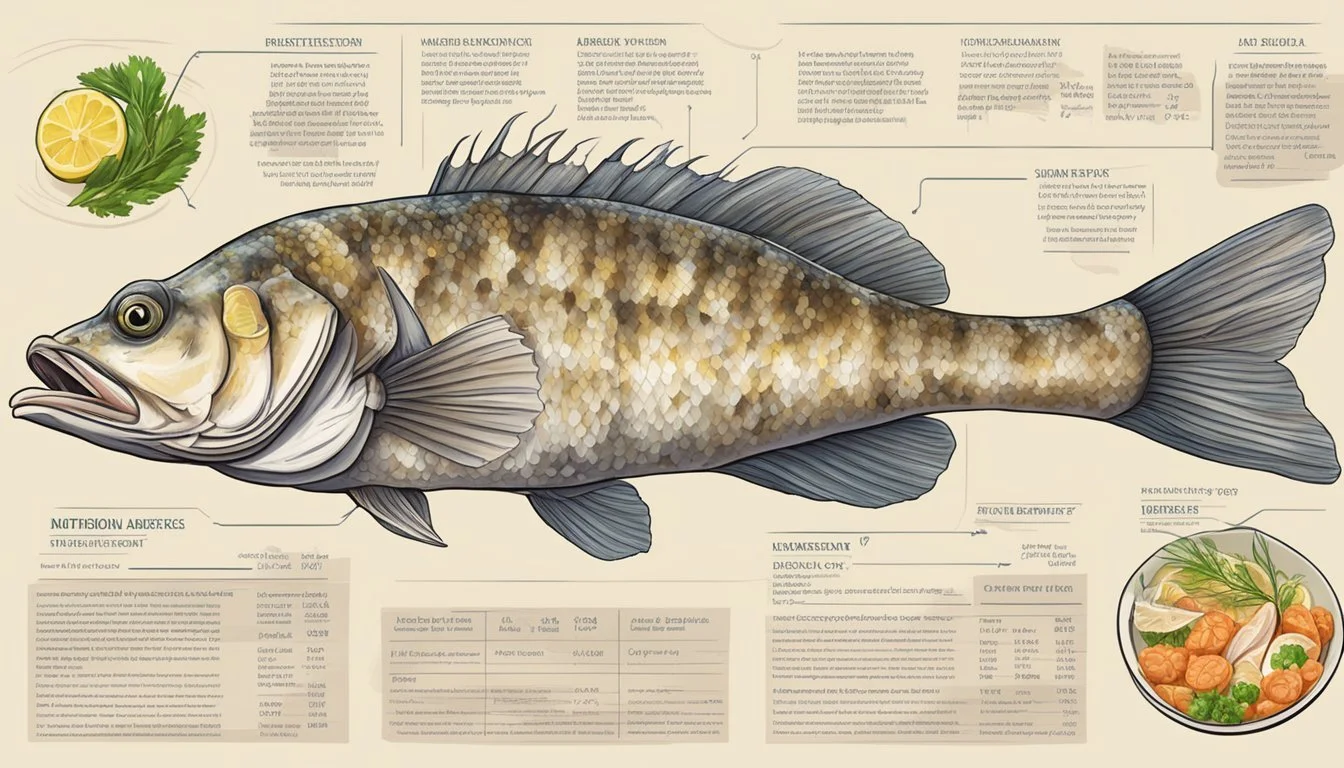Can Diabetics Eat Monkfish?
Understanding Health Implications
Monkfish, often referred to as the "poor man's lobster," has gained popularity for its firm texture and subtle flavor. But for individuals managing diabetes, the question arises: Can diabetics eat Monkfish? The straightforward answer is yes. Monkfish is low in fat and high in protein, making it an excellent choice for those who need to manage their blood sugar levels.
For diabetics, maintaining heart health is crucial due to the higher risk of cardiovascular diseases associated with the condition. Monkfish can support heart health because it's packed with essential nutrients like vitamins and minerals. These elements play a role in reducing the risk of heart-related issues.
In the context of a balanced diet, incorporating monkfish can be beneficial. It's not just about the benefits it offers for diabetes management but also its potential positive impacts on overall well-being. This makes monkfish a versatile and nutritious option worth considering for those with diabetes.
Understanding Diabetes and Dietary Needs
Individuals with diabetes must carefully consider their dietary choices to manage blood sugar levels effectively. Key dietary components include the impact of carbohydrates, the benefits of omega-3 fatty acids, and the significance of foods with a low glycemic index.
Impact of Diet on Blood Sugar Levels
Diet plays a crucial role in managing blood sugar levels, especially for individuals with Type 2 Diabetes and prediabetes. Carbohydrates are a primary focus because they break down into glucose rapidly. This can lead to spikes in blood sugar levels.
Reducing carbohydrate intake to 26-45% of total calories is often recommended. Non-starchy vegetables, healthy fats, protein sources, and quality carbohydrates in moderation are essential components of a diabetes-friendly diet. The goal is to avoid sharp increases in blood sugar while providing balanced nutritional needs.
The Role of Omega-3 Fatty Acids in Diabetes Management
Omega-3 fatty acids are beneficial for those managing diabetes. These fatty acids, found in certain fish like salmon, trout, and sardines, help improve insulin sensitivity. Improved insulin sensitivity allows more effective glucose metabolism.
Omega-3 fatty acids also possess anti-inflammatory properties, which reduce the risk of diabetes-related complications. Including omega-3-rich foods supports overall cardiovascular health, which is particularly important for diabetics. Ensuring consistent intake of these healthy fats can contribute to better long-term management of the condition.
Significance of Low Glycemic Index Foods
Low glycemic index (GI) foods are vital for maintaining stable blood sugar levels. Foods with a low GI are digested and absorbed more slowly, preventing rapid spikes in blood sugar. Examples include whole grains, legumes, non-starchy vegetables, and certain fruits.
These foods not only help control blood sugar but also aid in weight management and improve insulin resistance. Incorporating a variety of low GI foods into each meal provides sustained energy and prevents the sudden drops in blood sugar that can cause discomfort and health risks for diabetics.
Nutritional Profile of Monkfish
Monkfish, also known as "poor man's lobster," offers a variety of health benefits due to its rich nutritional profile. It is a lean source of protein and contains essential vitamins and minerals that can support overall health.
Macronutrients in Monkfish
Monkfish is an excellent source of protein, providing roughly 16-18 grams per serving. Its low-fat content makes it a healthy choice for those monitoring their fat intake. Per serving, monkfish contains less than 1 gram of saturated fat, making it heart-friendly. Additionally, it is low in cholesterol and sodium, which helps in maintaining cardiovascular health.
Nutritional Breakdown (per serving):
Calories: 189
Total Fat: 6 grams
Carbohydrates: 16 grams
Protein: 18 grams
Vitamins and Minerals Found in Monkfish
Monkfish is rich in essential vitamins and minerals that contribute to its health benefits. It is an outstanding source of Vitamin D, which supports bone health and the immune system. Monkfish also provides significant amounts of selenium and phosphorus. Selenium acts as an antioxidant, helping to protect cells from damage, while phosphorus is essential for bone and teeth strength.
Other important vitamins and minerals include B vitamins, which are critical for energy metabolism, and potassium, which helps regulate fluid balance and nerve signals.
Key Vitamins and Minerals:
Vitamin D: Supports bone health
Selenium: Antioxidant properties
Phosphorus: Bone health
B vitamins: Energy metabolism
Potassium: Fluid balance
Comparison of Monkfish to Other Seafood
When compared to other seafood, monkfish stands out for its unique nutritional composition. It is lower in both total fat and cholesterol than many other popular fish like salmon. While salmon is well-known for its high omega-3 fatty acid content, monkfish offers a leaner option that still provides a good protein source.
Another advantage is its lower mercury levels compared to species like tuna, making it a safer option for regular consumption. Monkfish also tends to contain fewer polychlorinated biphenyls (PCBs), which can be a concern with other types of seafood.
Comparison highlights:
Lower in fat and cholesterol than salmon
Lower in mercury than tuna
Fewer contaminants like PCBs
Monkfish in a Diabetic Diet
Monkfish can be a suitable seafood option for diabetics due to its low-fat content and high protein levels. Understanding how it affects blood sugar and the best ways to prepare it ensures it contributes positively to a diabetic diet.
How Monkfish Affects Blood Sugar and Metabolism
Monkfish provides lean protein, which is beneficial for blood sugar control.
Protein helps maintain steady glucose levels by slowing the absorption of carbohydrates. Monkfish has minimal carbohydrates, making it less likely to spike blood sugar levels.
Its low mercury content compared to other types of seafood reduces the risk of mercury exposure, which can impact metabolism and overall health.
Preparing Monkfish for Optimal Health Benefits
To maximize health benefits, prepare monkfish by grilling, baking, or roasting it with minimal added fats.
Use olive oil or other healthy fats to enhance flavor without adding unhealthy trans fats. Season with herbs and spices like garlic, rosemary, and lemon to keep it heart-healthy.
Avoid breading or frying, as these methods add extra carbohydrates and unhealthy fats.
Portion Sizes and Frequency of Consumption
For diabetics, a suitable portion size of monkfish is around 3-4 ounces per meal.
This amount provides enough protein without overwhelming the diet with excessive seafood. Eating monkfish 1-2 times a week can offer variety and maintain a balanced intake of nutrients.
Pair monkfish with non-starchy vegetables or whole grains to create a well-rounded meal that aligns with dietary guidelines for diabetes.
Health Benefits Beyond Diabetes
Monkfish provides several health benefits beyond its suitability for diabetics, primarily concerning heart health and bone strength. The fish is nutrient-dense, making it a valuable addition to a balanced diet.
Cardiovascular Health and Monkfish
Monkfish is beneficial for cardiovascular health due to its high content of omega-3 fatty acids. Omega-3s can improve heart health by lowering blood pressure, reducing triglycerides, and increasing HDL cholesterol levels.
The American Heart Association recommends the consumption of fish rich in omega-3s to reduce the risk of heart disease.
Monkfish also contains antioxidants, which help reduce inflammation, a common factor in heart disease and stroke. Regular consumption of monkfish can contribute to better heart health and lower the risk of cardiovascular events.
Bone Health and Vitamin Content
Monkfish is rich in essential vitamins and minerals that support bone health. It provides a good source of phosphorus and calcium, which are crucial for maintaining strong bones and teeth.
The fish also contains vitamin D, which aids in the absorption of calcium, enhancing bone strength. These nutrients work together to prevent bone-related disorders.
Moreover, the regular consumption of monkfish can help mitigate inflammation associated with conditions like osteoporosis. This makes monkfish a significant dietary choice for those looking to improve or maintain their bone health.
Monkfish Compared to Other Fish Varieties
Monkfish, known for its unique taste and texture, provides an interesting comparison to other fish varieties commonly consumed by diabetics. Below, the relative health benefits, mercury content, and sustainability of monkfish are explored.
Monkfish vs. Fatty Fish
Monkfish differs from fatty fish such as Salmon, Mackerel, and Sardines. Fatty fish are high in omega-3 fatty acids, essential for heart health and inflammation reduction. Monkfish, on the other hand, contains lower amounts of these beneficial fats.
Salmon and Mackerel are rich sources of omega-3s, which can help reduce triglycerides and improve cardiovascular health. While monkfish offers a good source of protein and vitamins, it pales in comparison to these fatty fish in terms of omega-3 content.
Mercury Content in Various Fish
Mercury content is crucial for those keen on maintaining long-term health. Monkfish falls into the moderate category for mercury levels, similar to other mid-range fish like Tuna and Trout.
Comparatively, fish like Swordfish and some Mackerel species have higher mercury levels, making them less suitable for regular consumption, especially for children and pregnant women. Lower mercury options include Salmon, Canned Salmon, Sardines, and Tilapia, making them safer choices than monkfish for frequent meals.
Sustainable Seafood Choices
Sustainability is key for responsible seafood consumption. Monkfish, when sourced from well-managed fisheries, can be a sustainable option. Yet, it's essential to check the source.
Tuna and Cod are often overfished or caught using methods that harm other marine life. Conversely, Canned Salmon, Shrimp, and Oysters offer more sustainably managed choices. Additionally, seafood like Lobster, if sourced responsibly, can also be a sustainable protein source compared to monkfish.
Dietary choices should balance health benefits, mercury content, and environmental impact. Knowing these differences helps make informed choices, particularly for individuals with dietary restrictions such as diabetics.
Culinary Applications of Monkfish
Monkfish is lauded for its versatility and mild flavor, making it an excellent option for various culinary methods. Its dense texture works well with an array of cooking techniques and flavor pairings suitable for people with diabetes.
Healthy Cooking Methods for Monkfish
Monkfish can be grilled, roasted, baked, or sautéed, providing multiple healthy options. Grilling monkfish gives it a smoky taste while keeping the calorie count low. Roasting monkfish at 400°F with olive oil and lemon juice preserves its moisture and adds a crisp texture. Baking is another excellent method; combine monkfish with vegetables like tomatoes, spinach, or broccoli for a nutrient-dense meal. Sautéing with garlic and olive oil enhances its natural flavor profile without adding excessive calories.
Flavor Pairings and Recipe Ideas
The mild flavor of monkfish pairs well with a variety of ingredients. Lemon and garlic are classic choices, lending a zesty brightness and depth. Tomatoes can add acidity and sweetness, while herbs like parsley or thyme introduce aromatic nuances.
Try a simple dish of roasted monkfish with lemon juice, garlic, and a side of broccoli. For a more elaborate option, monkfish medallions served on French lentils make an elegant presentation. Another delicious recipe involves monkfish in a tomato-based soup, seasoned with Mediterranean spices.
Alternative Options for Diabetic-Friendly Seafood Meals
For those seeking variety in their diabetic-friendly diet, other seafood options include baked salmon, grilled tofu, and sautéed shrimp. Salmon is rich in omega-3 fatty acids and pairs well with spinach or broccoli. Tofu offers a plant-based alternative with a similar dense texture to monkfish, especially when grilled or baked. Shrimp, when sautéed with garlic and olive oil, provides a quick meal high in protein and low in carbs.
These alternatives ensure that meal planning remains diverse while supporting a balanced, diabetic-friendly diet. Various recipes and preparation methods can be adjusted to align with individual dietary needs and preferences.
Safety and Consumption Guidelines
Diabetics can enjoy monkfish by adhering to specific safety and consumption guidelines. It's essential to understand FDA recommendations, identify fresh quality fish, and be aware of allergen information.
FDA Recommendations on Seafood Intake
The FDA advises consuming fish that are low in mercury, like monkfish, to promote heart health. Diabetics should aim for 8-12 ounces of seafood per week. This includes monkfish, which is rich in DHA and EPA. These fatty acids support cardiovascular well-being, a critical factor for those managing diabetes.
It's crucial to balance seafood intake with other sources of lean protein. Monitor for any seafood-related dietary reactions closely.
Identifying Freshness and Quality in Monkfish
To ensure safety, choosing fresh monkfish is vital. Look for firm, moist flesh with a slightly shiny appearance.
Smell: Fresh monkfish should have a clean, sea-like smell.
Appearance: Avoid fish with brownish edges or dry spots.
Labels: When purchasing from markets, check labels for sources like the North Atlantic for quality assurance.
Proper storage at the right temperature and quick consumption after purchase further ensures safety.
Allergen Information and Cross-Contamination Risks
While monkfish is generally safe, it's essential to be aware of potential shellfish allergies. Although monkfish is not a shellfish, cross-contamination can occur, especially if processed or stored near shellfish.
Preparation Tips:
Use separate utensils and cutting boards.
Clean surfaces thoroughly to avoid allergens.
For diabetics, understanding and mitigating cross-contamination risks can prevent adverse reactions, ensuring a safe seafood consumption experience.
Conclusion
Monkfish can be a suitable seafood option for people with diabetes. It is low in mercury compared to other fish like tuna and shark, making it a safer choice.
Monkfish is a good source of Vitamins B-6 and B-12, which are essential for overall health. These vitamins aid in energy production and proper nerve function.
The protein content in monkfish can help in managing blood sugar levels. Protein aids in satiety, reducing the temptation to overeat, which is crucial for diabetes management.
Diabetics should be cautious about how monkfish is prepared. Avoid recipes that involve heavy breading or frying. Opt for healthier cooking methods such as grilling, baking, or sautéing.
Incorporating monkfish into a balanced diet rich in Dietary Fiber, vegetables, and whole grains can contribute positively to health. Be mindful of portion sizes and complement the meal with other nutritious choices.
In summary, monkfish can be a beneficial addition to a diabetic-friendly diet when consumed in moderation and prepared healthily.









